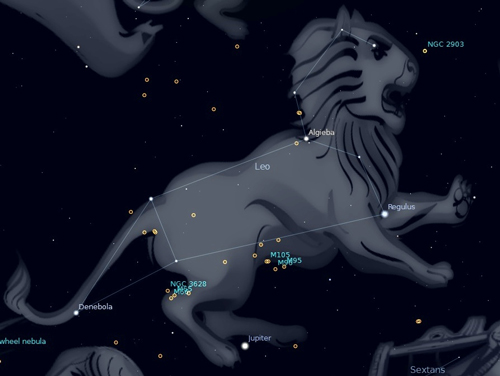
This Week’s Sky at a Glance, March 25 – April 1 ~by Curt Nason
What is the sign of spring for you? The first robin? For stargazers, spring is here when Leo the Lion clears the eastern horizon in twilight. Not only is it a sign of spring, it is a sign of the zodiac; one of the constellations that the Sun appears to travel through as our planet makes its annual orbit. A few thousand years ago the Sun passed in front of the stars of Leo at the height of summer, when the Nile River would rise and eventually flood its banks. Lions would bask at the riverside to escape the heat, and it doesn’t require a huge leap of imagination to see a lion in the stars of this area.
The constellation is composed of two prominent star patterns. A backwards question mark forms the lion’s neck and mane, with Leo’s brightest star marking the lion’s heart as the dot under the question mark. Eastward, to the left, is a triangle of stars representing its haunches and tail. The star at its heart is called Regulus, which means Little King. The Sun passes half its diameter below Regulus on August 22, more than a month later than it did when the constellation was named. Algieba, the bright star above Regulus, is actually two colourful stars when observed through a telescope.
In mythology Leo represents the Lion of Nemea, a beast with a hide impenetrable to anything but its own claws. Hercules was sent to kill the lion as the first of his twelve labours. After strangling it, he skinned the beast with its claws and used the pelt as a shield. If you look at the constellation backwards you might see a mouse, with the triangle as a mouse’s head and the backwards question mark as its tail, but having Hercules battle a mouse would not befit his legendary status.
This Week in the Solar System
Saturday’s sunrise in Moncton is at 7:12 am and sunset will occur at 7:38 pm, giving 12 hours, 26 minutes of daylight (7:17 am and 7:43 pm in Saint John). Next Saturday the Sun will rise at 6:58 am and set at 7:48 pm, giving 12 hours, 50 minutes of daylight (7:04 am and 7:52 pm in Saint John).
The Moon is new on Monday and on Tuesday evening a very slim crescent might be seen with binoculars above the sunset point. Mercury is at its best evening viewing over the next two weeks, reaching its greatest elongation from the Sun on April 1 when it sets 1 hour 45 minutes after sunset. Mars will be 15 degrees to its upper left. Jupiter rises in twilight this week. Use binoculars or a scope to watch its moon Ganymede disappear into the planet’s shadow around 9:40 Monday evening, and at 10:14 its moon Io will slowly emerge from behind the planet. Venus is at inferior conjunction this weekend and it can be seen before sunrise in the east. Look for Saturn above the spout of the Sagittarius Teapot.
The Saint John Astronomy Club meets at 7 pm on April 1 at the Rockwood Park Interpretation Centre. All are welcome.
Questions? You can contact Curt Nason here.
